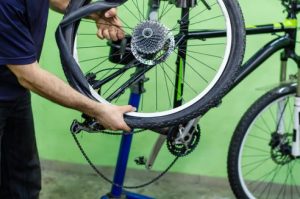
Mountain biking is an exhilarating experience, but to keep the thrill alive, it’s crucial to ensure your mountain bike is well-maintained. One key aspect of maintenance is understanding How to Change a Mountain Bike Tire. In this guide, we’ll take you through the process step by step, from recognizing signs of wear to upgrading to high-performance tires.
Before we dive into the nitty-gritty of changing a Mountain Bike Tire, let’s briefly touch on why it’s essential. Your bike’s tires play a pivotal role in providing stability, traction, and control during rides. Regular maintenance, including tire changes, ensures a smoother and safer biking experience.
How to Change a Mountain Bike Tire?
Whether you’re an avid mountain biker or a casual rider, knowing how to change a tire is a fundamental skill. Regular maintenance ensures a hassle-free experience on the trails. In this guide, we’ll walk you through the process step by step.
Understanding Your Mountain Bike Tire
Not all Mountain Bike Tire are created equal. Understanding the different types can significantly impact your ride. From knobby to slick tires and tubeless to tubed options, each serves a specific purpose. Knowing the right tire for your biking style is the first step in effective maintenance.
Signs of a Worn-Out Tire
Recognizing when it’s time to change your Mountain Bike Tire is crucial. We’ll explore how to check for worn-out tread, identify cuts or bulges, and monitor air pressure to keep your tires in top shape.
Tools Needed for Changing a Mountain Bike Tire
To change a Mountain Bike Tire, you will need the following tools and materials:
New Mountain Bike Tire:
Ensure you have a replacement tire that is compatible with your mountain bike. Check the tire size and type to match your riding preferences and terrain.
Tire Levers:
While not strictly necessary, tire levers can be very helpful for easing the removal and installation of the tire from the rim.
Bike Pump:
A reliable bike pump is essential for inflating the new tire to the recommended pressure once it’s installed.
Wrench:
If your bike has bolts securing the wheel (as opposed to quick-release skewers), you’ll need a wrench to loosen and remove the bolts.
Clean Rag:
A clean rag comes in handy for wiping off any dirt or debris from the wheel, rim, and other components during the tire-changing process.
These tools and materials will cover the basics for changing a Mountain Bike Tire. It’s a good idea to carry them with you, especially on longer rides, in case you need to perform a tire change while out on the trail.
Step-by-Step Guide to Changing a Mountain Bike Tire

Now, let’s get hands-on. We’ll guide you through the entire process, ensuring safety at every step. From removing the wheel to installing the new tire and reattaching the wheel, you’ll be back on the trail in no time.
10 Tips for Mountain Bike Tire Maintenance
Certainly! Proper maintenance of your Mountain Bike Tire is essential for a safe and enjoyable riding experience. Here are ten tips for Mountain Bike Tire maintenance:
1 Check Tire Pressure Regularly:
Maintain the recommended tire pressure, which is usually indicated on the sidewall of the tire. Use a reliable pressure gauge and adjust according to the terrain and your riding style.
2 Inspect Tread Wear:
Regularly check the tread pattern for signs of wear. Worn-out treads can compromise traction and increase the risk of slipping, especially in challenging off-road conditions.
3 Look for Cuts and Punctures:
Inspect the tire surface for cuts, punctures, or any visible damage. If you find any, address them promptly by either patching or replacing the tire.
4 Examine the Sidewalls:
Check the sidewalls of the tires for cuts, bulges, or other abnormalities. Damaged sidewalls can lead to blowouts, so replace the tire if you notice any issues.
5 Keep Valves Tight and Straight:
Ensure that the valve stems are straight and properly tightened. A loose or crooked valve can result in air leaks and affect tire performance.
6 Maintain Proper Wheel Alignment:
Misaligned wheels can cause uneven tire wear. Periodically check the wheel alignment and make adjustments as needed to ensure a smooth and stable ride.
7 Use Sealant for Tubeless Tires:
If you have tubeless tires, regularly check the sealant levels. Top up the sealant as necessary to prevent flats caused by small punctures.
8 Rotate Tires:
To promote even wear, consider rotating your tires regularly. Swap the front and rear tires to ensure that they wear down more uniformly, extending the overall lifespan of your tire set.
9 Clean Your Tires After Rides:
Remove debris, mud, and other contaminants from your tires after each ride. A clean tire not only looks better but also performs better by maintaining optimal grip.
10 Store Your Bike Properly:
When not in use, store your bike in a cool, dry place, away from direct sunlight. Avoid prolonged exposure to extreme temperatures, as this can affect tire rubber and lead to premature deterioration.
By following these maintenance tips, you’ll not only enhance the longevity of your Mountain Bike Tire but also ensure a safer and more enjoyable riding experience on diverse terrains. Regular checks and prompt action when needed can prevent unexpected issues and contribute to a smoother ride.
Troubleshooting Common Issues
Encountering difficulties? We’ve got you covered. From stubborn tires to unexpected punctures on the trail, we’ll provide solutions to keep you rolling smoothly.
Upgrading Your Mountain Bike Tires
For those looking to enhance their biking experience, we’ll discuss choosing the right tire for your riding style and the benefits of upgrading to high-performance options.
FAQs
Can I use any tire for my mountain bike?
Yes, but ensure it matches the wheel diameter and type (tube or tubeless).
How often should I check my bike tires?
Regularly inspect before each ride, looking for signs of wear or damage.
Is it possible to patch a bike tire instead of replacing it?
Yes, if the damage is minor, a patch kit can be a quick and effective solution.
Can I change a bike tire without tire levers?
While possible, tire levers make the process significantly easier and less likely to damage the tube.
What’s the difference between Presta and Schrader valves?
Presta valves are slender and used in high-performance bikes, while Schrader valves are broader and more common on standard bikes.
How tight should I tighten the bolts when reattaching the wheel?
Tighten bolts snugly, ensuring the wheel is secure, but avoid over-tightening to prevent damage.
Conclusion
Changing a Mountain Bike Tire might seem daunting at first, but with the right knowledge, it becomes a simple yet essential skill. Regular maintenance ensures a safer and more enjoyable biking experience. So, gear up, follow our guide, and hit the trails with confidence!

certainly like your website but you need to take a look at the spelling on quite a few of your posts Many of them are rife with spelling problems and I find it very troublesome to inform the reality nevertheless I will definitely come back again
thanks